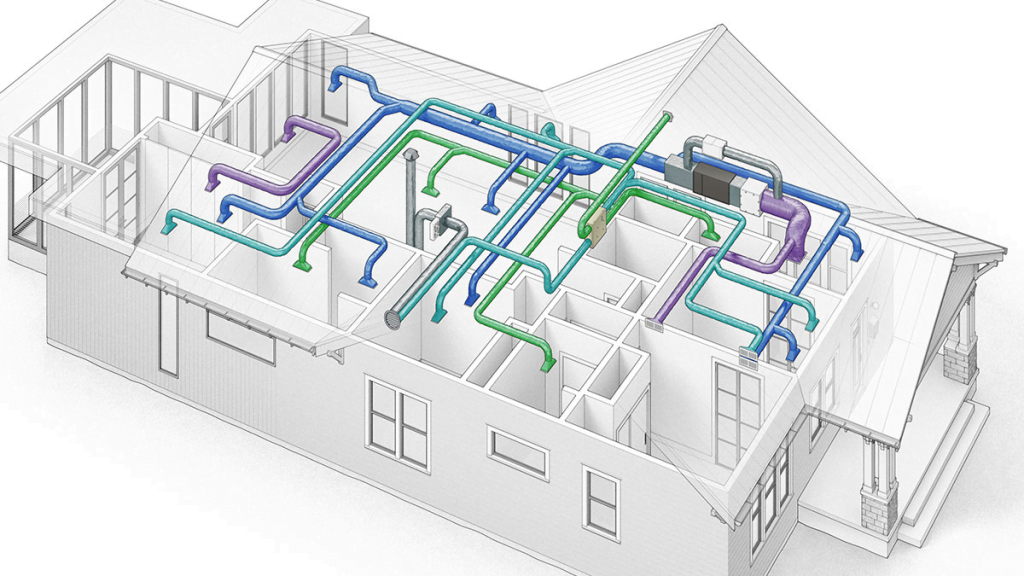Supporting the Future Homes Standard and Energy Performance Certificate, Dusun IoT’s KNX Gateway Paves the Way for Smarter, Energy-Efficient Building Automation and Home Energy Management.
As the demand for smarter, energy-efficient buildings continues to rise, the need for advanced home energy management solutions has never been greater. In response to these industry trends, Dusun IoT is proud to introduce DSGW-510 multi-protocol KNX gateway, designed to streamline building automation while driving sustainable energy use.

With its ability to integrate a wide range of communication protocols and interfaces—including KNX, Wi-Fi, Ethernet, M-bus, CAN, Cellular, Zigbee/Z-Wave/BLE, I/Os, USB3.0, and more—this versatile gateway enables seamless control over multiple systems, making it the ideal solution for both residential and commercial properties that prioritize energy conservation and smart automation.
What is KNX Protocol and Why It’s Popular in Home and Building Automation?
The KNX protocol has established itself as a dominant standard and go-to choice for smart building automation solutions globally. It is a standardized (ISO/IEC 14543) home and building control protocol that is able to integrate and control multiple building devices through one streamlined network, with the flexibility for wired (twisted pair) and wireless (KNX RF) installations. This versatility makes it suitable for both residential and commercial settings, powering a wide range of applications—from lighting and shade control to sophisticated security systems, HVAC, water management, and energy monitoring.
What is a KNX Gateway?
A KNX gateway acts as a bridge between the KNX system and other networks or devices, facilitating seamless communication across multiple protocols. Think of it as a protocol conversion gateway that enables the integration of KNX with third-party platforms like smart home systems, building management systems, cloud services, or even other communication protocols like IP. By providing this interface, a KNX gateway enhances interoperability, allowing KNX-controlled systems to connect effortlessly with non-KNX products. Whether integrating new devices or bridging legacy systems, the KNX gateway makes it easier to manage and control diverse technologies under one unified platform.
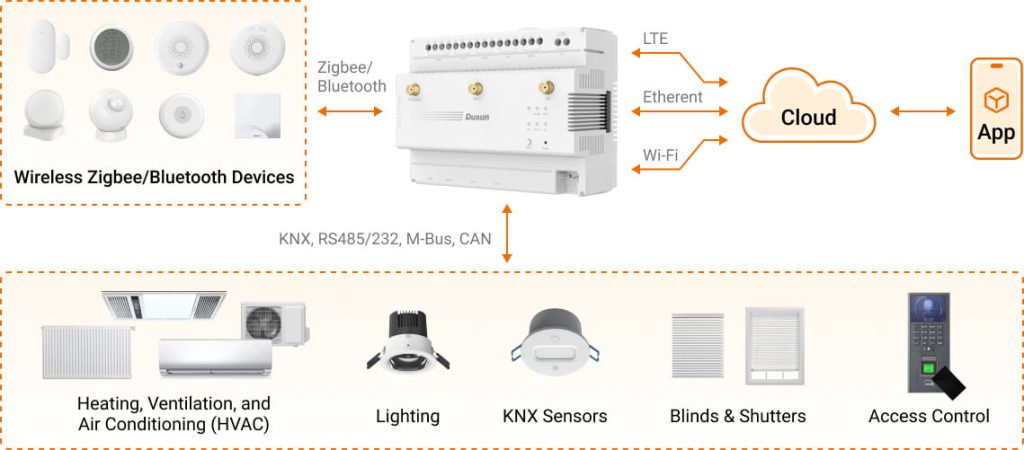
Features of DSGW-510 KNX Gateway Hardware
Dusun IoT is excited to announce the release of its next-generation KNX gateway, a versatile hardware that not only supports KNX but also integrates seamlessly with various other protocols. It is designed for future scalabilitym and aim to supercharge your smart building automation solutions. Let’s explore what makes this DSGW-510 KNX gateway truly distinctive in today’s market.
High-Performance CPU
Powered by a Hexa-core RK3399 processor, featuring a dual-core ARM Cortex-A72 and quad-core ARM Cortex-A53, DSGW-510 KNX gateway ensures rapid processing and efficient handling of complex tasks. With 4GB DDR3 RAM and 32GB eMMC storage, it is designed for demanding home automation, building automation, HVAC automation, and industrial control applications. The gateway supports Debian 12, Ubuntu 18.04, Android 10.0, and Buildroot+QT, making it fully programmable. Developers can also leverage Dusun IoT’s SDK documents for secondary firmware development.
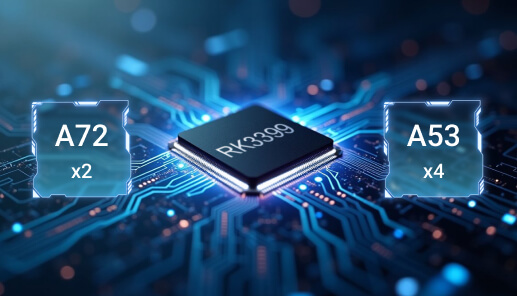
KNX Support
Available in two versions—one using STMicroelectronics KNX SoC and three variants featuring Onsemi KNX SoCs—both models fully support standard datapoints (DPTs) for seamless integration with KNX devices and systems. Whether integrating lighting control or energy management, DSGW-510 KNX gateway ensures easy and efficient KNX-based automation.
Multi-Protocol Data Delivery & Protocol Conversion
Designed for ultimate versatility, DSGW-510 KNX gateway also supports a wide range of communication standards: Ethernet (two RJ45 Gigabit Ethernet ports), KNX, Wi-Fi (2.4 and 5GHz), 4G LTE (Cat 1/Cat 4), and a choice of BLE, Zigbee, or Z-Wave. This makes it ideal for connecting diverse systems and performing protocol conversions across various smart devices.
Rich Interfaces for Future-Proof Scalability
With two RS485, two USB 3.0, one RS232, one M-Bus, and one CAN interface, DSGW-510 KNX gateway is designed for future scalability. It also features expansion I/O interfaces, allowing for local bus interface functions—perfect for installations that may require additional connectivity down the road.
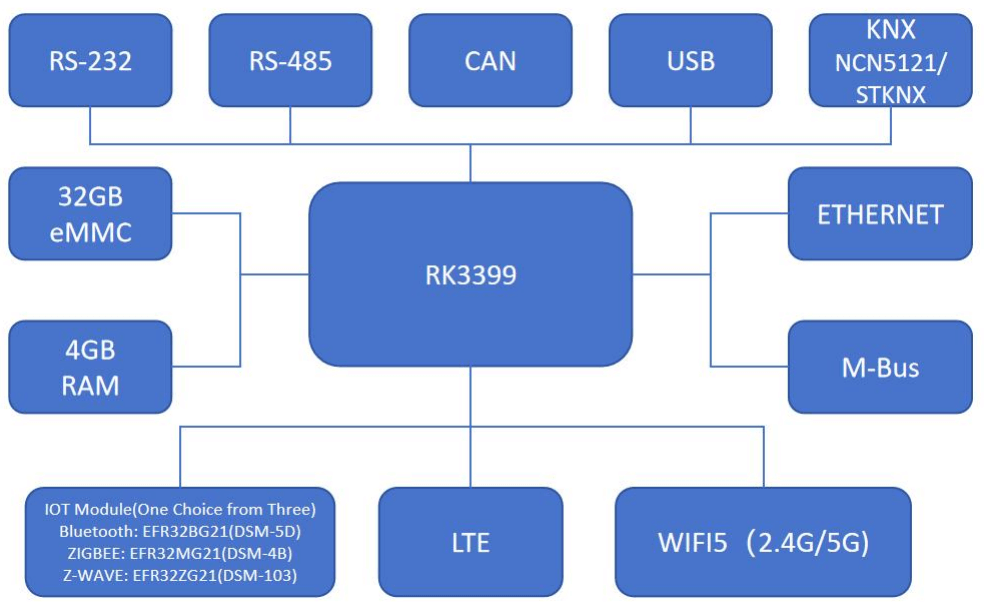
Embedded M-Bus Level Converter
DSGW-510 KNX gateway comes with a built-in M-Bus level converter, eliminating the need for external converters and simplifying installation while saving on equipment costs.
HDMI Support
DSGW-510 KNX gateway also supports HDMI, expanding its usability for local display or configuration through external screens.
DIN Rail Installation
Designed for easy integration into existing systems, DSGW-510 KNX gateway supports DIN rail installation, making it ideal for professional and industrial setups.
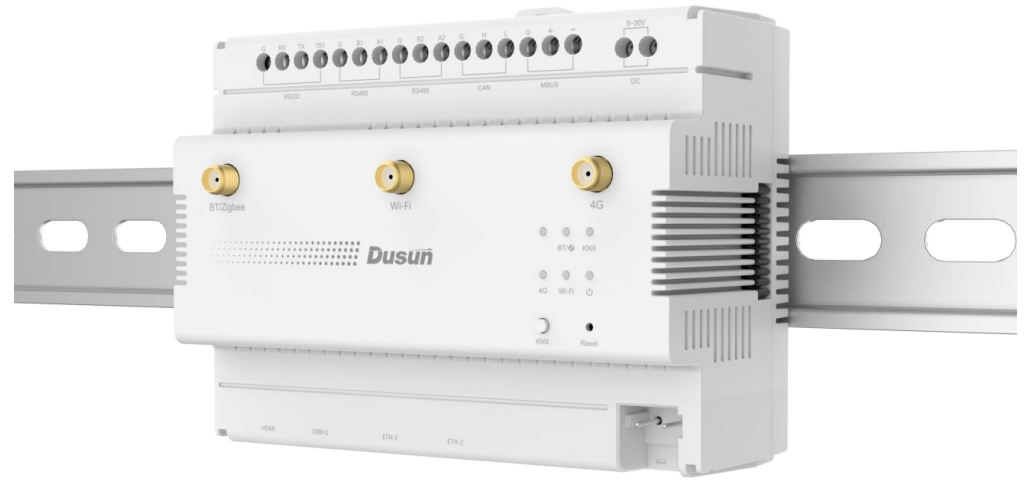
Use Cases of DSGW-510 KNX Gateway
As the landscape of smart building technology evolves, KNX IoT is making significant strides toward enhanced compatibility with IoT devices and the energy sector. The KNX gateway plays a pivotal role in this transformation, enabling seamless control and integration with renewable energy sources. With the impending introduction of the Future Homes Standard and the Energy Performance Certificate, the focus on sustainable energy management will intensify. This shift underscores the importance of the KNX gateway in facilitating efficient energy use and enhancing the interoperability of smart technologies, ultimately driving the future of intelligent building automation. Let’s check out uses cases of DSGW-510 KNX gateway.
Lighting Control
Effortlessly manage and automate lighting throughout the space, optimizing energy use while enhancing ambiance. Whether it’s dimming lights in a conference room or setting schedules for outdoor lighting, the KNX gateway enables seamless integration and control.
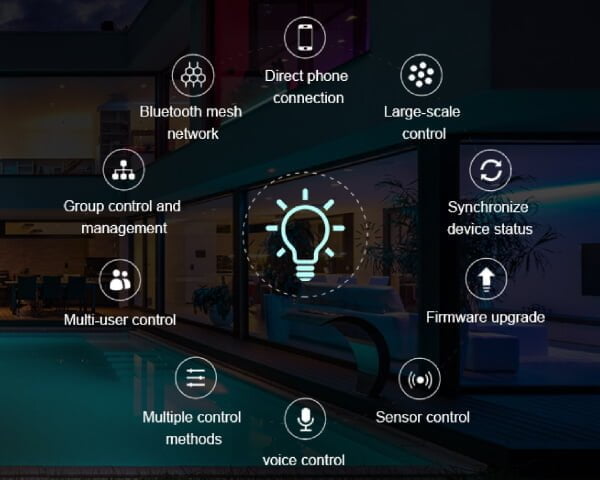
HVAC Management
Achieve ideal climate control by integrating HVAC systems with the KNX gateway. Monitor and adjust heating, ventilation, and air conditioning settings remotely, ensuring comfort while minimizing energy consumption.
Blind and Shutter Automation
Automate the opening and closing of blinds and shutters based on time of day, sunlight levels, or occupancy, enhancing energy efficiency and privacy. This feature allows for greater control over natural light and temperature regulation.
Access Control
Enhance security with integrated access control solutions. The KNX gateway allows for the management of entry systems, enabling remote monitoring and control of access points within residential or commercial facilities.
Suitable Facilities of Using DSGW-510 KNX Gateway
- Home: Transform living space into a smart home where automation enhances comfort, security, and energy efficiency.
- Hotels: Improve guest experiences by automating lighting, HVAC, and access control systems, all while optimizing energy usage.
- Apartments: Offer residents modern conveniences with centralized control of various building systems, enhancing both comfort and security.
- Commercial Buildings: Streamline operations in office environments with automated control over lighting, HVAC, and security systems, promoting a productive atmosphere.
- Metro Stations: Enhance operational efficiency and safety by integrating various systems, including lighting and access control, for better management of public transportation facilities.
- Airports: Ensure a seamless travel experience with automated control of lighting, climate, and access systems, making airports more efficient and comfortable for passengers.
Final Words – Building Energy-efficient Home/Building Automation Solutions Together
In a world where smart technology is redefining the future of building automation, DSGW-510 KNX gateway might be an ideal hardware solution for those who are seeking a versatile KNX gateway to enhance smart home or building automation solutions. We sincerely invite you to explore this device and experience the difference.
FAQs of KNX Gateways
Is DSGW-510 a KNX IP gateway?
Yes, the DSGW-510 is a KNX IP gateway. This device supports KNX, WiFi, and Ethernet. It is designed to facilitate the communication and integration between KNX systems and Internet-based networks. By converting KNX telegrams into IP packets, it allows KNX devices to communicate over IP networks, thus enabling remote access and control of KNX installations via smartphones, tablets, or web interfaces.
Is DSGW-510 a KNX Zigbee gateway?
Yes, DSGW-510 can functions as a KNX Zigbee gateway. It supports both KNX and Zigbee, as well as many other protocols and interfaces, thus enabling integration and interoperability between KNX systems and wireless Zigbee networks. This integration allows various devices within a building automation system, like lighting, heating, and security systems, to communicate and operate together.
Is DSGW-510 a KNX RS485 gateway?
DSGW-510 supports KNX protocol and include two RS485 Phoenix terminals, so it can potentially serve as a KNX RS485 gateway to facilitate communication between KNX systems and RS485 devices.
RS485 is a standard commonly used for serial communication in industrial and building automation applications. DSGW-510 gateway is able to translates KNX protocol messages into RS485 protocol messages and vice versa, enabling communication between disparate systems.
Is DSGW-510 a KNX RS232 gateway?
DSGW-510 can support communication with KNX-based systems and has an RS232 terminal to connect to legacy or standard devices that use this serial protocol for communication. A KNX RS232 gateway is designed to enable communication between a KNX system and devices using the RS232 serial communication protocol. KNX protocol is widely used in building automation for controlling lighting, heating, and other systems, while RS232 protocol is commonly used for serial communication in various types of electronic equipment.
Is DSGW-510 a KNX USB gateway?
DSGW-510 KNX gateway features two USB 3.0 ports, which could be used for USB-based communication with a KNX system. E.g. A computer or other USB-compatible device can interface with a KNX network, allowing for communication and management of the KNX devices through a USB connection. If the USB ports are intended for general use and not specifically for KNX communication, when used on KNX gateways, they might serve other purposes such as connectivity for external storage, peripheral devices, or additional networking functions.
USB 3.0 ports provide high-speed data transfer capabilities. Two USB 3.0 ports allow DSGW-510 KNX gateway to handle real-time data exchange between the KNX system and the connected USB device, such as group addresses, datatypes, and telegrams, aiding in seamless automation tasks and updates.
Is DSGW-510 a KNX Ethernet gateway?
DSGW-510, with its two RJ45 Gigabit Ethernet ports, could potentially serve as a KNX Ethernet gateway. The two Gigabit Ethernet ports allow for high-speed data transmission, which is beneficial for handling the communication workload associated with building automation and KNX data traffic.
Is DSGW-510 a KNX WiFi gateway?
DSGW-510 KNX gateway support both 2.4 GHz and 5 GHz WiFi bands, adapting to different networking needs. The 2.4 GHz band provides broader coverage and better penetration through walls, which is beneficial in larger or more obstructed areas. Meanwhile, the 5 GHz band offers higher speeds and less interference, ideal for high-bandwidth applications and environments densely populated with devices.
As a KNX WiFi gateway, DSGW-510 gateway’s dual-band capabilities could enable smooth integration of KNX systems with existing home or building networks, allowing KNX devices to connect and communicate with a wide range of smart home solutions and IoT platforms.
On the other hand, utilizing WiFi capabilities, DSGW-510 can facilitate remote monitoring and control of the KNX network through smart devices, enhancing user convenience and system manageability.
Is DSGW-510 a KNX Bluetooth gateway?
DSGW-510 KNX gateway supports Bluetooth Low Energy protocol, and enables the inclusion of Bluetooth-enabled devices, such as smartphones, sensors, or other IoT devices, into a KNX-controlled environment. As Bluetooth is widely used for personal devices, users can control and monitor KNX systems directly from Bluetooth-enabled devices, such as smartphones or tablets.









